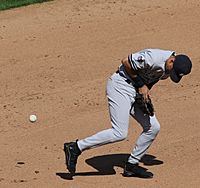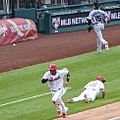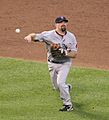Error (baseball) facts for kids
In baseball, an error (often shortened to E) is a mistake made by a defensive player. An official scorer decides if a player made an error. This mistake lets a batter get on base or a baserunner move to another base. This happens when the player should have been able to make the play with normal effort.
When a player makes an error, it usually doesn't count as a hit for the batter. However, it still counts as an "at-bat." Sometimes, a batter might have gotten to first base safely anyway, but the error lets them get even further. In that case, the play can be counted as both a hit and an error. If a batter only gets on base because of a mistake, it's called a "hit on error." This is like getting out, and it lowers the batter's batting average.
Contents
How Errors Affect Runs Batted In
A batter usually does not get credit for a run batted in (RBI) when runs score because of an error. But there's an exception! If the scorer thinks a run would have scored even without the mistake, the batter can still get an RBI. For example, if a batter hits a ball that should be a sacrifice fly, and the outfielder drops it, the batter still gets credit for the sacrifice fly and the RBI.
Errors and Fielder's Choice
Sometimes, a play should have been a fielder's choice. This means a runner would be out, and the batter would be safe. But if the runner is safe because of an error, the play is still called a fielder's choice. The batter does not get a hit, and the fielder gets an error.
What Is Not an Error?
Some mistakes are not counted as errors. For example, a passed ball is when a catcher misses a pitch that they should have caught. A wild pitch is when a pitcher throws a ball that is too hard to catch. These are special categories and are not scored as errors.
Images for kids
-
Tommy John is one of several pitchers who committed three errors in a single inning.
-
Hall of Famer Eddie Collins holds the American League record for most career errors by a second baseman.
See also
 In Spanish: Error (béisbol) para niños
In Spanish: Error (béisbol) para niños






